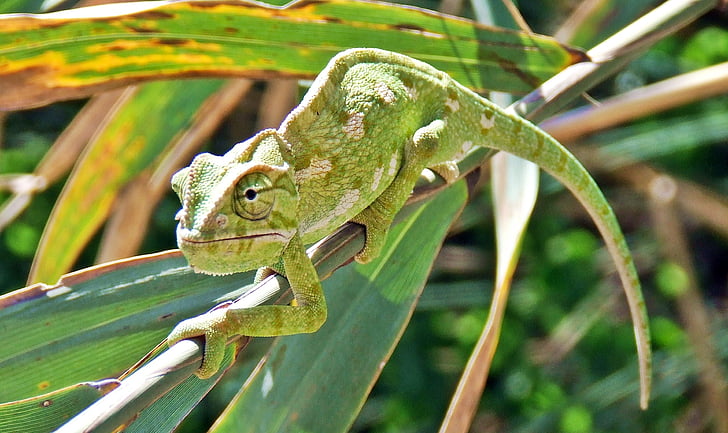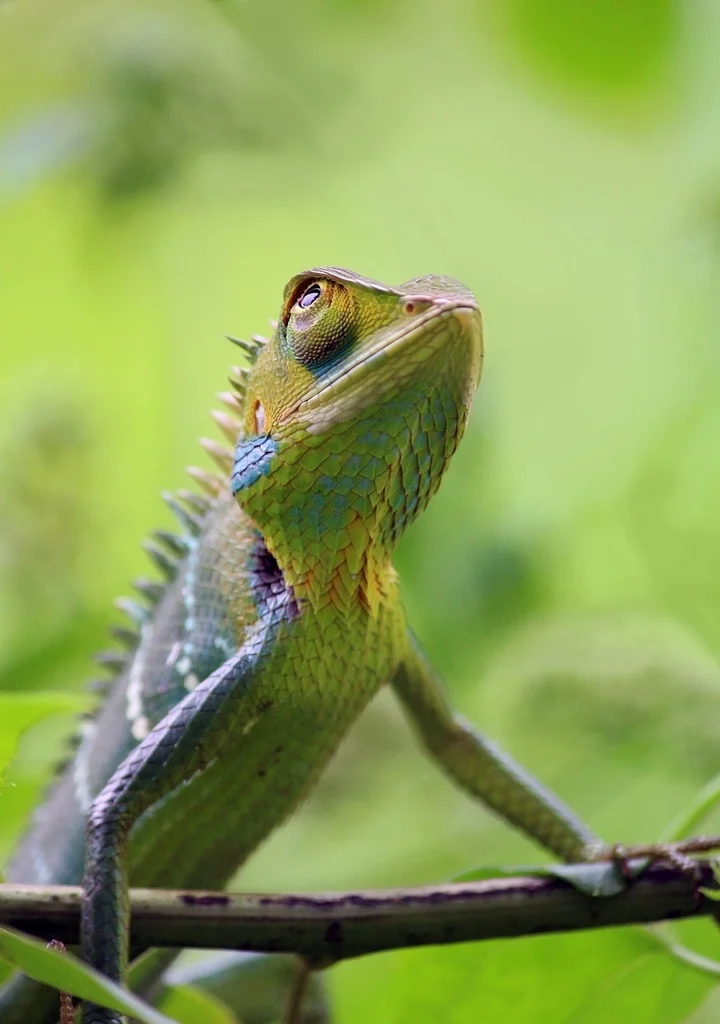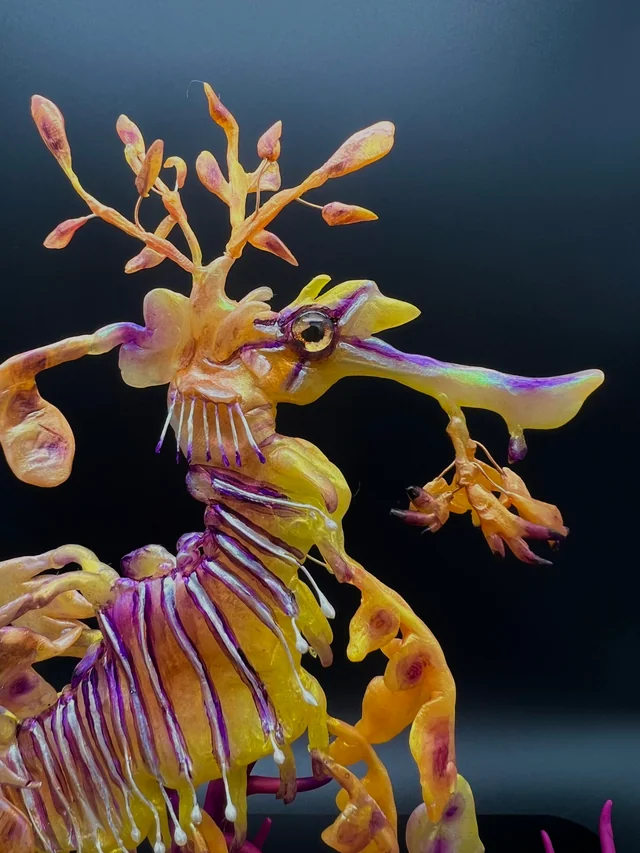Do Chameleon Bites Hurt?

Among the myriad questions that arise in the minds of curious observers, one stands out: do Chameleon Bites Hurt? Yes, a chameleon bite may hurt, but it is not a typical danger to humans. Chameleons have small, sharp teeth and can make painful bites if they feel threatened or stressed.
These enigmatic creatures, renowned for their ability to change colors and navigate diverse ecosystems, evoke both wonder and caution in those who encounter them. As we embark on a journey to uncover the truth behind Bites Hurt, we delve into the intricate anatomy and behavior of chameleons.
Behind their mesmerizing appearance lies a question that intrigues both seasoned reptile enthusiasts and curious novices alike.
What is the reality behind a Chameleon bite? Through exploration and discovery, we aim to shed light on this elusive topic, offering valuable insights for those who seek to understand these fascinating reptiles better.
Join us as we unravel the mysteries surrounding chameleon bites, dispel myths, and empower you with the knowledge to navigate the world of chameleons with confidence and curiosity. Let’s embark on this adventure together and uncover the truth.
Chameleon Anatomy and Behavior
Chameleons boast a unique set of anatomical features that distinguish them from other reptiles. Their characteristic bulging eyes, independently rotating turret-like eyes and prehensile tails are just a few of the remarkable adaptations that have captivated researchers and nature enthusiasts alike.
Different Types of Chameleons
Chameleons are of different colors, shapes, and behaviors that have intrigued and fascinated humans for centuries.
From the towering rainforests of Madagascar to the arid deserts of Africa, chameleons have evolved to thrive in a variety of environments, each species carving out its niche in the ecosystem.
-
Panther Chameleon (Furcifer pardalis)
With its vibrant hues and striking patterns, the panther chameleon is perhaps one of the most iconic species in the chameleon family.
Endemic to Madagascar, this arboreal reptile is renowned for its ability to change color rapidly, displaying a dazzling array of greens, blues, reds, and yellows.
The panther chameleon’s elongated body, prehensile tail, and independently rotating eyes make it a master of camouflage and a formidable predator in its native habitat.
-
Veiled Chameleon (Chamaeleo calyptratus)
Named for the distinctive casque or “veil” on its head, the veiled chameleon is another popular species among reptile enthusiasts.
Native to the mountainous regions of Yemen and Saudi Arabia, this arboreal lizard exhibits a range of coloration, including shades of green, turquoise, and yellow.
With its robust build and casque adorned with protrusions known as “tubercles,” the veiled chameleon is well-adapted to its mountainous habitat, where it hunts insects and small vertebrates with precision.
-
Jackson’s Chameleon (Trioceros jacksonii)
Hailing from the mist-shrouded forests of East Africa, Jackson’s chameleon is a striking species known for its three distinctive horns and bumpy casque.
Unlike many other chameleon species, Jackson’s chameleons give birth to live young rather than laying eggs, a unique reproductive strategy that sets them apart.
With their slow-moving demeanor and arboreal lifestyle, these chameleons are well-suited to life in the dense vegetation of their native habitat, where they feed on insects and small invertebrates.
-
Pygmy Chameleon (Rhampholeon spp.)
As their name suggests, pygmy chameleons are diminutive members of the chameleon family, with some species measuring just a few inches in length.
Endemic to the rainforests of Central and East Africa, these tiny reptiles possess many of the same characteristics as their larger relatives, including independently rotating eyes and a prehensile tail.
Despite their small size, pygmy chameleons are skilled hunters, using their projectile tongues to capture unsuspecting prey.
-
Parson’s Chameleon (Calumma parsonii)
The Parson’s chameleon, native to Madagascar, is one of the largest chameleon species in the world, with some individuals reaching lengths of up to two feet.
Known for its distinctive coloration, which ranges from bright green to deep blue and yellow, the Parson’s chameleon is a striking sight in its native rainforest habitat.
With its slow-moving demeanor and impressive size, this species plays a vital role in its ecosystem as both predator and prey.
Anatomy of Chameleon Mouth: Teeth, Jaws, and Bite Force
The mouth of a chameleon is equipped with a formidable array of tools for capturing prey and defending against threats. Sharp, curved teeth line the edges of their jaws, enabling them to grip onto prey with precision.
Despite their relatively small size, chameleon jaws possess remarkable strength, capable of exerting significant pressure when necessary.
How Chameleons Use Their Bite
Contrary to popular belief, Chameleon Bites Hurt as a last line of defense when confronted with a perceived threat.
Their primary means of defense lies in their remarkable ability to blend into their surroundings and evade detection. However, if provoked or cornered, a chameleon may resort to biting as a means of self-preservation.
Factors Influencing Bite Severity
-
Impact of Chameleon Size on Bite Intensity
The size of a chameleon can significantly influence the severity of its bite. Larger species, such as the veiled chameleon, possess more substantial jaws and teeth, capable of inflicting more significant injuries compared to their smaller counterparts.
However, even smaller chameleon species should not be underestimated, as their bites can still cause discomfort and minor injuries.
-
Bite Differences Across Chameleon Species
Different chameleon species exhibit varying levels of aggression and defensive behavior, which can influence the severity of their bites.
Some species, such as the Jackson’s chameleon, are known for their relatively docile temperament and are less likely to bite unless provoked. In contrast, other species, such as the aggressive panther chameleon, may be more prone to biting when threatened.
Accounts from Chameleon Owners
Many chameleon owners have firsthand experience with chameleon bites and can provide valuable insights into their perceived pain levels.

While some may describe chameleon bites as merely uncomfortable or startling, others may report more significant pain and discomfort, depending on the circumstances of the bite and the individual’s pain threshold.
What Does Science Say about Chameleon Bites?
Scientific research on Chameleon Bites Hurt and their perceived pain levels is relatively scarce. However, studies on reptile bites in general suggest that pain perception can vary widely among individuals.
This may be influenced by factors such as bite location, the force of the bite, and individual pain tolerance. Further research is needed to elucidate the specific pain response to chameleon bites accurately.
Mitigating Chameleon bites
-
Minimizing the Risk of Getting Bitten
One of the most effective ways to avoid chameleon bites is to employ proper handling techniques when interacting with these reptiles.
Avoid sudden movements or attempts to grab or restrain the chameleon, as this can provoke defensive behavior and increase the risk of getting bitten. Instead, allow the chameleon to approach you voluntarily and handle them gently and with care.
-
Establishing a Bond with Your Chameleon
Building a bond of trust with your chameleon can help minimize the likelihood of getting bitten during interactions.
Spend time observing your chameleon’s behavior and body language, and gradually acclimate them to your presence through positive reinforcement techniques such as offering treats and gentle handling.
By earning their trust and respect, you can foster a mutually rewarding relationship with your chameleon while minimizing the risk of bites.
Debunking Myths and Misconceptions
-
Myth: Chameleon Bites Are Extremely Painful
One common myth surrounding chameleon bites is that chameleon Bites are excruciatingly painful. While chameleon bites can certainly be uncomfortable and may cause minor injuries such as puncture wounds or scratches, they are generally not considered to be exceptionally painful.
chameleon bites are comparable to a sharp pinch or pressure and typically resolve without the need for medical intervention.
-
Myth: Chameleons Are Aggressive and Always Bite
Another prevalent misconception is that chameleons are inherently aggressive and prone to biting. In reality, chameleons are typically shy and reserved creatures that prefer to avoid conflict whenever possible.
Biting is usually a last resort for chameleons when they feel threatened or cornered. With proper care and handling, chameleons can become tame and docile pets that rarely resort to biting.
What to Do If You Get Bitten by Chameleon
If you find yourself on the receiving end of a chameleon bite, it’s essential to remain calm and assess the situation.
Wash the bite wound thoroughly with soap and water to reduce the risk of infection, and apply an antiseptic ointment if available. Monitor the wound for signs of inflammation or infection, and seek medical attention if necessary.
Treating Chameleon Bite Injuries
Most chameleon bite injuries are minor and require little more than basic first aid. However, if the bite wound appears to be deep or becomes red, swollen, or painful, it may indicate an infection or other complications.
In such cases, it’s essential to seek medical attention promptly to prevent further complications and ensure proper wound healing.
Strategies to Avoid Getting Bitten
Preventing chameleon bites begins with understanding and respecting your chameleon’s boundaries. Avoid handling your chameleon excessively or in a rough manner, as this can provoke defensive behavior and increase the likelihood of getting bitten.
Additionally, provide your chameleon with a comfortable and stress-free environment that meets their physical and psychological needs to minimize the risk of aggressive behavior.
Teaching Your Chameleon to Trust You
Training your chameleon to trust you can help reduce the risk of bites and foster a stronger bond between you and your pet.
Spend time interacting with your chameleon daily, offering treats and positive reinforcement to reward calm and cooperative behavior. Gradually introduce handling and socialization exercises, taking care to respect your chameleon’s comfort level and boundaries throughout the process.
Understanding Chameleon Behavior
-
Recognizing Signs of Discomfort or Agitation
Chameleons are sensitive creatures that are highly attuned to their environment. Signs of stress or discomfort, such as color changes, rapid breathing, or hissing, can indicate that your chameleon feels threatened or anxious.
It’s essential to monitor your chameleon’s behavior closely and take steps to alleviate stressors in their environment to promote their health and well-being.
Interpreting Chameleon Body Language
Chameleons communicate through a variety of visual cues and body language signals. Color changes, body posture, and eye movements can convey important information about your chameleon’s mood, health, and intentions.
By learning to interpret these signals, you can better understand your chameleon’s needs and preferences and provide them with appropriate care and enrichment.
Conclusion
Chameleon bites are often misunderstood and misrepresented, leading to unfounded fears and misconceptions among prospective chameleon owners.
While chameleon bites can certainly be uncomfortable and may cause minor injuries, they are generally not as severe or painful as commonly believed.
By understanding chameleon anatomy, behavior, and the factors that influence bite severity, chameleon owners can minimize the risk of bites and foster a positive relationship with their pets.
Empowering chameleon owners with accurate information and practical tips for safe interaction is essential for promoting responsible chameleon ownership.
By debunking myths and misconceptions surrounding chameleon bites and providing guidance on proper handling techniques and care practices, we can ensure that chameleon owners are well-equipped to provide optimal care for their beloved pets.








